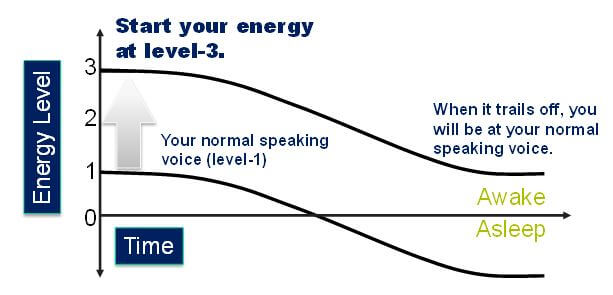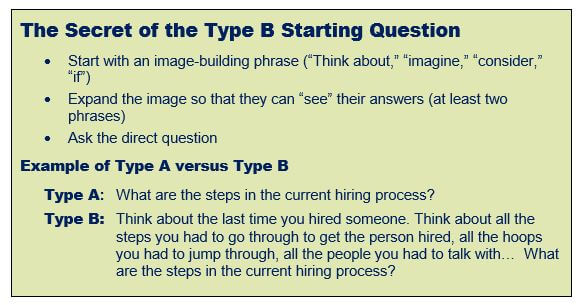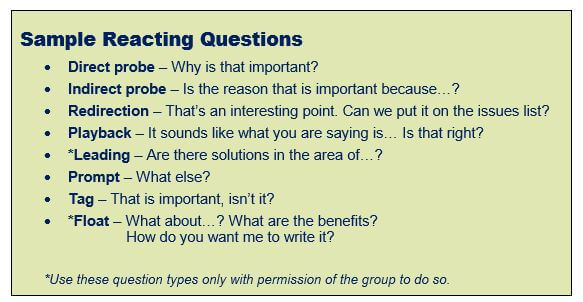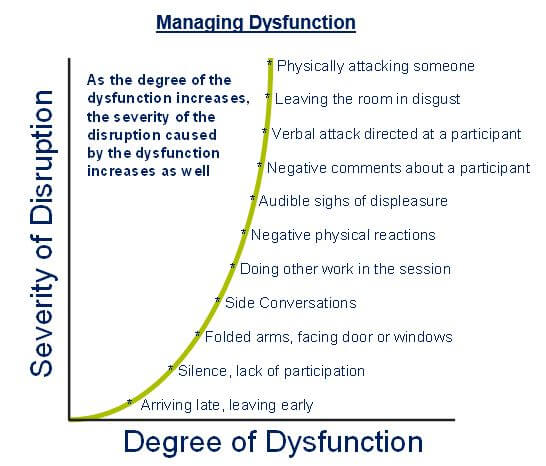What is it that separates great facilitators from good ones? Sure, every facilitator needs to know about establishing ground rules, using the appropriate tools, listening, building trust, and maintaining a safe environment. But, are there a set of skills that seem to distinguish the best facilitators from the rest of the pack?
We say, “Yes!” As facilitators and facilitation trainers, we have had the opportunity to train over 20,000 facilitators since releasing our training class, The Effective Facilitator, in 1993. While some facilitators were beginners, most were experienced, and many were very experienced. It was through working with this wide variation in proficiency that we have identified what we believe are The Seven Separators – the key skills that seem to separate the great facilitators from the average ones.
It takes numerous skills to be a great facilitator. But, for facilitators who are already good at the mechanics and are seeking to achieve facilitation excellence, we recommend that you focus on these seven skill areas.
The Seven Separators
1. Great facilitators know that it is important to establish and maintain a high energy level. Whether you are working with a group in a week-long program or facilitating a quality team that meets for two hours once a week, your participants are looking to you to set the pace. Why set it high? We have found that high energy does three important things:
- Engages the group by getting their attention, gaining their interest, and keeping it fun

- Energizes the topic indirectly (i.e., the facilitator’s energy suggests to the participants, “This must be important because this person seems to be excited about it.”)
- Increases the perception of facilitator’s self-confidence; continually, we have found that the complementary perception is also made: facilitators with low energy are perceived by participants as having low self-confidence!
2. In every facilitated session, there are specific times when the facilitator stops speaking and is looking to the group to speak considerably. This is very characteristic of brainstorming or listing exercises. Average facilitators figure out what questions they want to ask. Great facilitators are very conscious that the way they ask “starting questions” will greatly influence the quality of the responses. So, they ask starting questions that draw a vivid image. People can “see” their answers and are very quickly able to respond with information that is directly on the topic.

3. Good facilitators accept the responses given by participants and summarize when necessary. Great facilitators quickly analyze the responses provided and have a full toolkit of follow-up question types to apply to a variety of situations. Sometimes, they will ask playback questions to verify what was said; other times, they may ask direct probes to challenge, redirections to get back on topic, leading questions to get out of a hole, etc.

4. Good facilitators do an adequate job of recording the gist of what they heard the participants say. They may change the wording here or there to clarify and may record what the person “meant.” In some cases, they may choose not to record certain points that they deem unimportant. In other cases, they look to the group to decide whether someone’s point is worthy of recording. Great facilitators recognize the “power of the pen” and understand how abuse of the pen disempowers individuals and can cause dysfunctional behavior. Great facilitators record the participants’ words (not necessarily all of them) instead of their own. They write what was said, regardless of their perception of value. Once written, they use their follow-up questions to get the participant to clean up the words.
5. While average facilitators know the mechanics to handle a group in a facilitated session, great facilitators carry the group through the process. While average facilitators cover the agenda items, great facilitators smoothly transition from one agenda item to the next. Great facilitators use checkpoints every step of the way – with every new agenda item, they review what’s been done, they preview what’s going to be done, and explain in big view how the new agenda item contributes to the objectives established in the beginning of the session. Great facilitators use examples to ensure that participants understand. Great facilitators have a model for giving directions that allows them to always give accurate, clear, and concise instructions.
6. Average facilitators understand that dysfunctional behavior by participants can derail a facilitated session. Therefore, they tend to be a bit fearful of dysfunction. They often ignore the early forms of dysfunction and hope and pray that it goes away quickly should it occur. Great facilitators know that hope is not a strategy! During preparation, they seek to identify potential dysfunction and take steps in advance for conscious prevention, early detection and clean resolution of dysfunctional behavior. Should a dysfunction occur, they quickly recognize it and have specific strategies for addressing the dysfunctions that commonly occur.

7. Every facilitation situation is unique. Yet, great facilitators design customized processes to address a sponsor’s need. Great facilitators have a core set of standard agenda processes from which to draw, and they know the cues for determining which agenda is appropriate in a given situation. They also have a method for building a new agenda process from scratch when needed and have a full tool box of engagement strategies to choose from. Not fully satisfied with having a standard method for brainstorming, grouping or prioritizing, great facilitators also have a full suite of alternative engagement strategies such as dump and clump, rotating flip charts, last person standing, gifts and hooks, and three question panic.
The seven skills highlighted above are based on the experience of our organization and are just a few of the key techniques covered by the facilitation methodology we teach in The Effective Facilitator. Your experience may be different, and we welcome your comments. Twenty years ago, many thought that a flip chart and a pen was all you needed to be a good facilitator. Today, we know it takes considerably more. Join our efforts to continually raise the bar on facilitation excellence.
Learn these seven core skills plus 100 facilitation techniques in our flagship course, The Effective Facilitator. This course provides a comprehensive, structured approach for leading groups toward better results.
About the Author
Michael Wilkinson is the trailblazing Founder of Leadership Strategies, renowned as the foremost provider of professional facilitators and facilitation training in the US. As a Certified Master Facilitator and a Certified Professional Facilitator, Michael’s expertise is in high demand as a trainer, facilitator, and keynote speaker. With a track record of leadership in the facilitation industry, including roles as past president of the Southeast Association of Facilitators, creator of the FindaFacilitator.com database, and founding board member of the International Institute of Facilitation, Michael is a leader in the industry. Dive deeper into his wealth of knowledge through his acclaimed books, including The Executive Guide to Facilitating Strategy, The Secrets of Facilitation, The Secrets to Masterful Meetings, and CLICK: The Virtual Meetings Book.

